Postoperative Care for Appendectomy: Patient Assessment and Recovery
VerifiedAdded on 2022/12/30
|7
|1309
|99
Report
AI Summary
This report focuses on the postoperative care of a patient, Erica, who has undergone an appendectomy. It begins with the preparation of the recovery room, emphasizing the importance of proper ventilation to prevent complications such as anoxia, dyspnea, and hypoventilation. The report then details the assessment of the patient, specifically addressing acute pain, the risk of deficient fluid volume, and the risk of infection. Interventions for pain management include the administration of analgesics and the use of ice bags. Fluid volume is monitored through blood pressure, pulse, I&O, and urine analysis, with electrolyte and IV fluid administration to address dehydration. The report also outlines discharge planning, providing Erica with instructions on incision care, diet, activity limitations, and follow-up appointments. Documentation of patient information, including any operative complications, is emphasized for future reference. The report cites several research papers supporting the practices described.
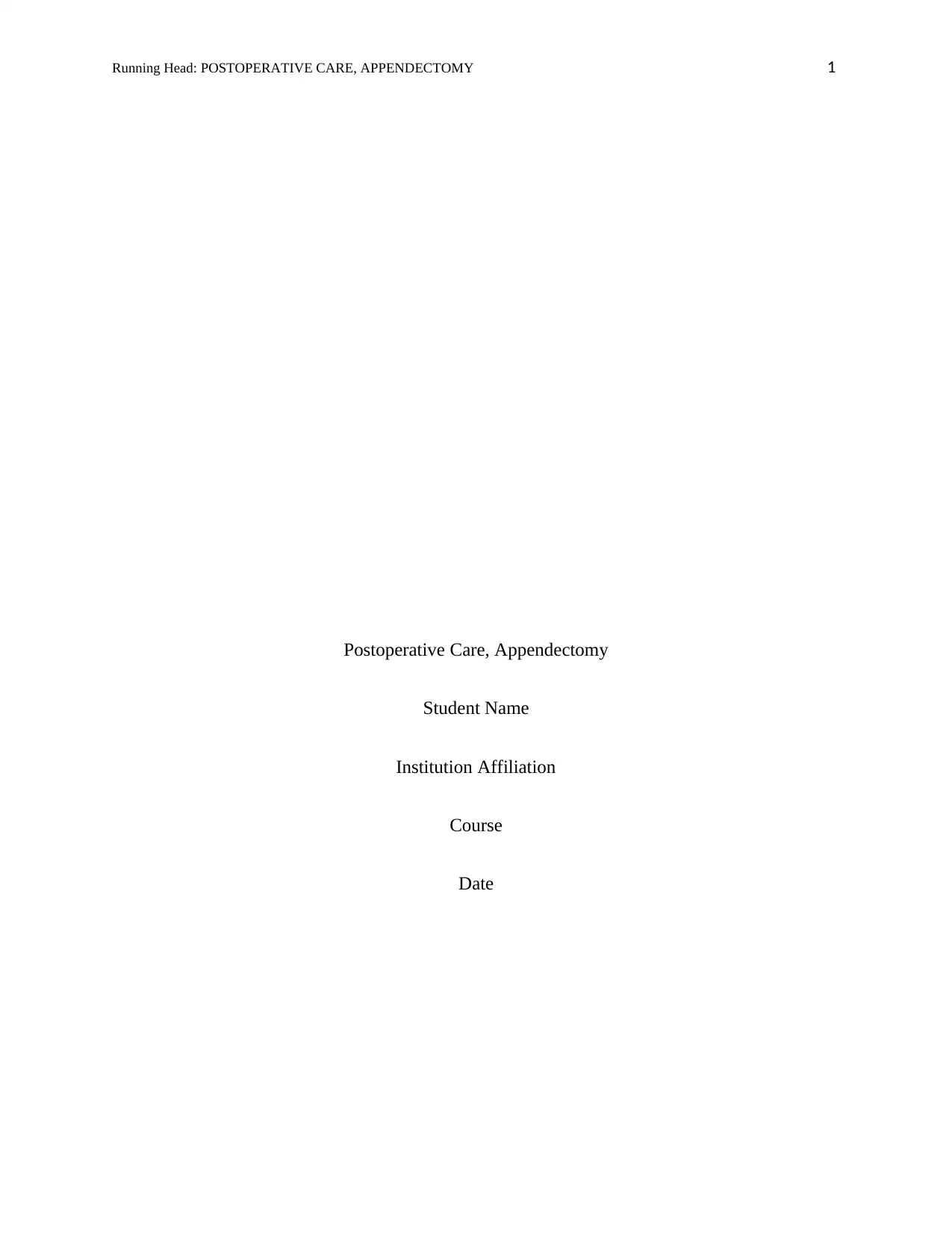
Running Head: POSTOPERATIVE CARE, APPENDECTOMY 1
Postoperative Care, Appendectomy
Student Name
Institution Affiliation
Course
Date
Postoperative Care, Appendectomy
Student Name
Institution Affiliation
Course
Date
Paraphrase This Document
Need a fresh take? Get an instant paraphrase of this document with our AI Paraphraser
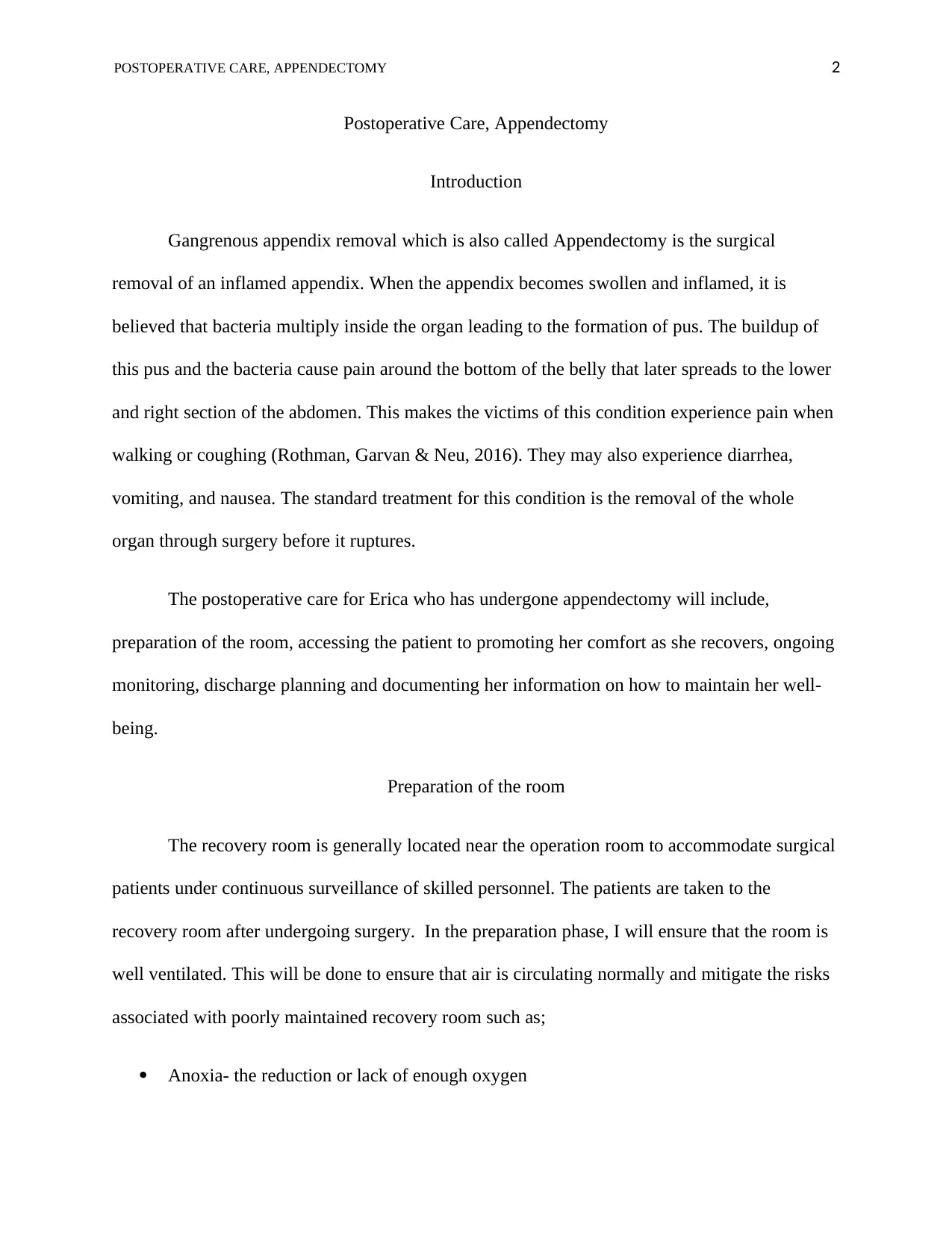
POSTOPERATIVE CARE, APPENDECTOMY 2
Postoperative Care, Appendectomy
Introduction
Gangrenous appendix removal which is also called Appendectomy is the surgical
removal of an inflamed appendix. When the appendix becomes swollen and inflamed, it is
believed that bacteria multiply inside the organ leading to the formation of pus. The buildup of
this pus and the bacteria cause pain around the bottom of the belly that later spreads to the lower
and right section of the abdomen. This makes the victims of this condition experience pain when
walking or coughing (Rothman, Garvan & Neu, 2016). They may also experience diarrhea,
vomiting, and nausea. The standard treatment for this condition is the removal of the whole
organ through surgery before it ruptures.
The postoperative care for Erica who has undergone appendectomy will include,
preparation of the room, accessing the patient to promoting her comfort as she recovers, ongoing
monitoring, discharge planning and documenting her information on how to maintain her well-
being.
Preparation of the room
The recovery room is generally located near the operation room to accommodate surgical
patients under continuous surveillance of skilled personnel. The patients are taken to the
recovery room after undergoing surgery. In the preparation phase, I will ensure that the room is
well ventilated. This will be done to ensure that air is circulating normally and mitigate the risks
associated with poorly maintained recovery room such as;
Anoxia- the reduction or lack of enough oxygen
Postoperative Care, Appendectomy
Introduction
Gangrenous appendix removal which is also called Appendectomy is the surgical
removal of an inflamed appendix. When the appendix becomes swollen and inflamed, it is
believed that bacteria multiply inside the organ leading to the formation of pus. The buildup of
this pus and the bacteria cause pain around the bottom of the belly that later spreads to the lower
and right section of the abdomen. This makes the victims of this condition experience pain when
walking or coughing (Rothman, Garvan & Neu, 2016). They may also experience diarrhea,
vomiting, and nausea. The standard treatment for this condition is the removal of the whole
organ through surgery before it ruptures.
The postoperative care for Erica who has undergone appendectomy will include,
preparation of the room, accessing the patient to promoting her comfort as she recovers, ongoing
monitoring, discharge planning and documenting her information on how to maintain her well-
being.
Preparation of the room
The recovery room is generally located near the operation room to accommodate surgical
patients under continuous surveillance of skilled personnel. The patients are taken to the
recovery room after undergoing surgery. In the preparation phase, I will ensure that the room is
well ventilated. This will be done to ensure that air is circulating normally and mitigate the risks
associated with poorly maintained recovery room such as;
Anoxia- the reduction or lack of enough oxygen
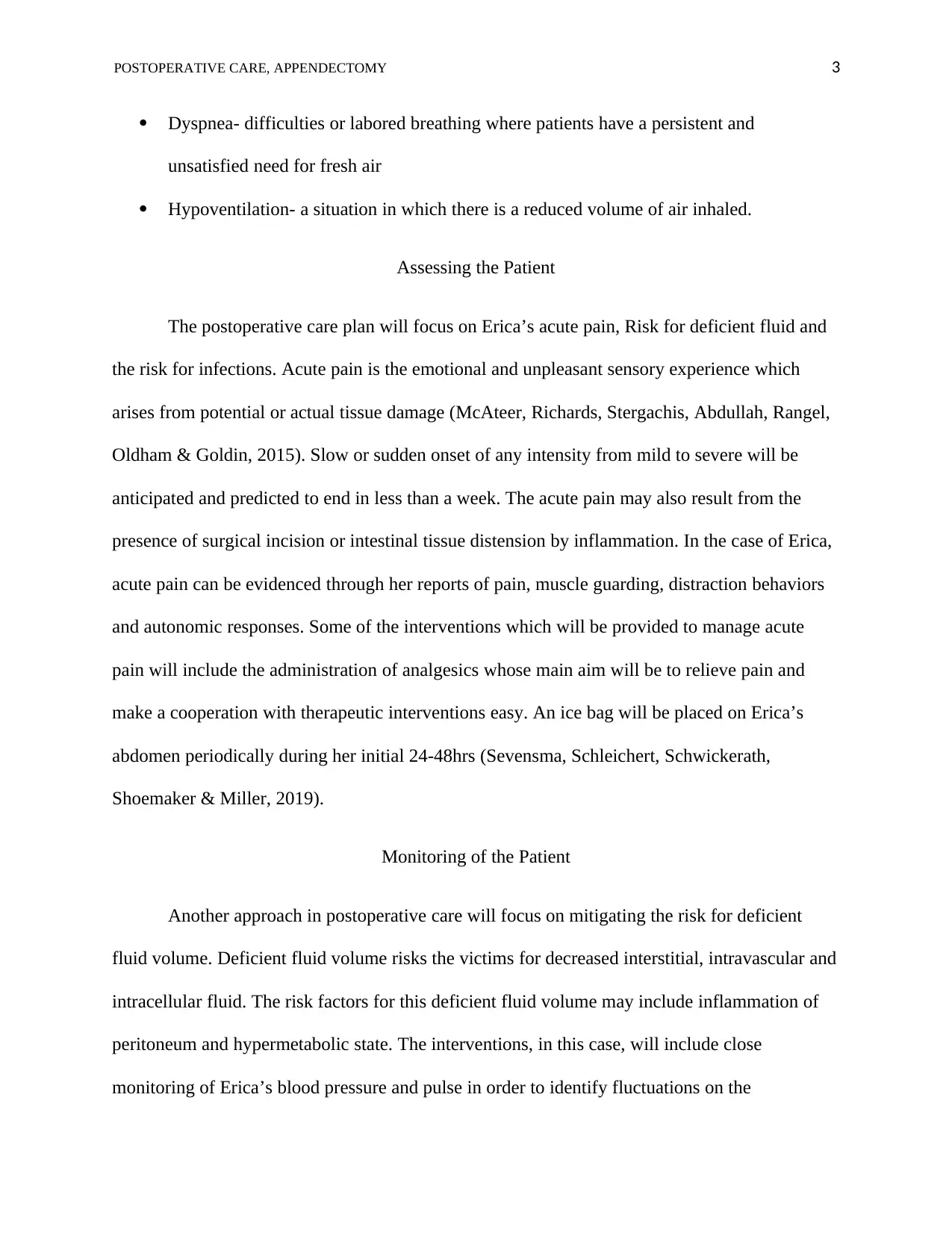
POSTOPERATIVE CARE, APPENDECTOMY 3
Dyspnea- difficulties or labored breathing where patients have a persistent and
unsatisfied need for fresh air
Hypoventilation- a situation in which there is a reduced volume of air inhaled.
Assessing the Patient
The postoperative care plan will focus on Erica’s acute pain, Risk for deficient fluid and
the risk for infections. Acute pain is the emotional and unpleasant sensory experience which
arises from potential or actual tissue damage (McAteer, Richards, Stergachis, Abdullah, Rangel,
Oldham & Goldin, 2015). Slow or sudden onset of any intensity from mild to severe will be
anticipated and predicted to end in less than a week. The acute pain may also result from the
presence of surgical incision or intestinal tissue distension by inflammation. In the case of Erica,
acute pain can be evidenced through her reports of pain, muscle guarding, distraction behaviors
and autonomic responses. Some of the interventions which will be provided to manage acute
pain will include the administration of analgesics whose main aim will be to relieve pain and
make a cooperation with therapeutic interventions easy. An ice bag will be placed on Erica’s
abdomen periodically during her initial 24-48hrs (Sevensma, Schleichert, Schwickerath,
Shoemaker & Miller, 2019).
Monitoring of the Patient
Another approach in postoperative care will focus on mitigating the risk for deficient
fluid volume. Deficient fluid volume risks the victims for decreased interstitial, intravascular and
intracellular fluid. The risk factors for this deficient fluid volume may include inflammation of
peritoneum and hypermetabolic state. The interventions, in this case, will include close
monitoring of Erica’s blood pressure and pulse in order to identify fluctuations on the
Dyspnea- difficulties or labored breathing where patients have a persistent and
unsatisfied need for fresh air
Hypoventilation- a situation in which there is a reduced volume of air inhaled.
Assessing the Patient
The postoperative care plan will focus on Erica’s acute pain, Risk for deficient fluid and
the risk for infections. Acute pain is the emotional and unpleasant sensory experience which
arises from potential or actual tissue damage (McAteer, Richards, Stergachis, Abdullah, Rangel,
Oldham & Goldin, 2015). Slow or sudden onset of any intensity from mild to severe will be
anticipated and predicted to end in less than a week. The acute pain may also result from the
presence of surgical incision or intestinal tissue distension by inflammation. In the case of Erica,
acute pain can be evidenced through her reports of pain, muscle guarding, distraction behaviors
and autonomic responses. Some of the interventions which will be provided to manage acute
pain will include the administration of analgesics whose main aim will be to relieve pain and
make a cooperation with therapeutic interventions easy. An ice bag will be placed on Erica’s
abdomen periodically during her initial 24-48hrs (Sevensma, Schleichert, Schwickerath,
Shoemaker & Miller, 2019).
Monitoring of the Patient
Another approach in postoperative care will focus on mitigating the risk for deficient
fluid volume. Deficient fluid volume risks the victims for decreased interstitial, intravascular and
intracellular fluid. The risk factors for this deficient fluid volume may include inflammation of
peritoneum and hypermetabolic state. The interventions, in this case, will include close
monitoring of Erica’s blood pressure and pulse in order to identify fluctuations on the
⊘ This is a preview!⊘
Do you want full access?
Subscribe today to unlock all pages.

Trusted by 1+ million students worldwide
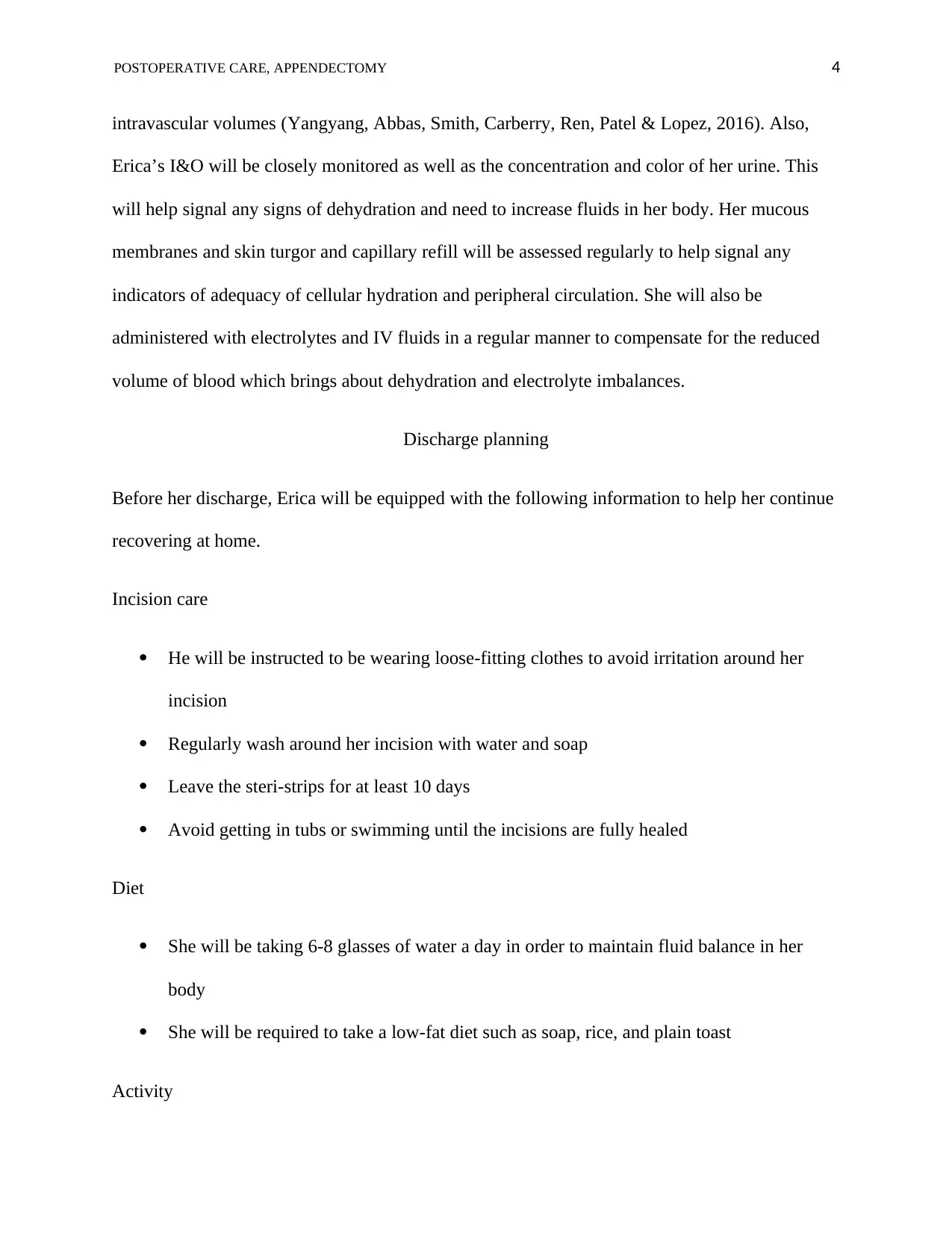
POSTOPERATIVE CARE, APPENDECTOMY 4
intravascular volumes (Yangyang, Abbas, Smith, Carberry, Ren, Patel & Lopez, 2016). Also,
Erica’s I&O will be closely monitored as well as the concentration and color of her urine. This
will help signal any signs of dehydration and need to increase fluids in her body. Her mucous
membranes and skin turgor and capillary refill will be assessed regularly to help signal any
indicators of adequacy of cellular hydration and peripheral circulation. She will also be
administered with electrolytes and IV fluids in a regular manner to compensate for the reduced
volume of blood which brings about dehydration and electrolyte imbalances.
Discharge planning
Before her discharge, Erica will be equipped with the following information to help her continue
recovering at home.
Incision care
He will be instructed to be wearing loose-fitting clothes to avoid irritation around her
incision
Regularly wash around her incision with water and soap
Leave the steri-strips for at least 10 days
Avoid getting in tubs or swimming until the incisions are fully healed
Diet
She will be taking 6-8 glasses of water a day in order to maintain fluid balance in her
body
She will be required to take a low-fat diet such as soap, rice, and plain toast
Activity
intravascular volumes (Yangyang, Abbas, Smith, Carberry, Ren, Patel & Lopez, 2016). Also,
Erica’s I&O will be closely monitored as well as the concentration and color of her urine. This
will help signal any signs of dehydration and need to increase fluids in her body. Her mucous
membranes and skin turgor and capillary refill will be assessed regularly to help signal any
indicators of adequacy of cellular hydration and peripheral circulation. She will also be
administered with electrolytes and IV fluids in a regular manner to compensate for the reduced
volume of blood which brings about dehydration and electrolyte imbalances.
Discharge planning
Before her discharge, Erica will be equipped with the following information to help her continue
recovering at home.
Incision care
He will be instructed to be wearing loose-fitting clothes to avoid irritation around her
incision
Regularly wash around her incision with water and soap
Leave the steri-strips for at least 10 days
Avoid getting in tubs or swimming until the incisions are fully healed
Diet
She will be taking 6-8 glasses of water a day in order to maintain fluid balance in her
body
She will be required to take a low-fat diet such as soap, rice, and plain toast
Activity
Paraphrase This Document
Need a fresh take? Get an instant paraphrase of this document with our AI Paraphraser
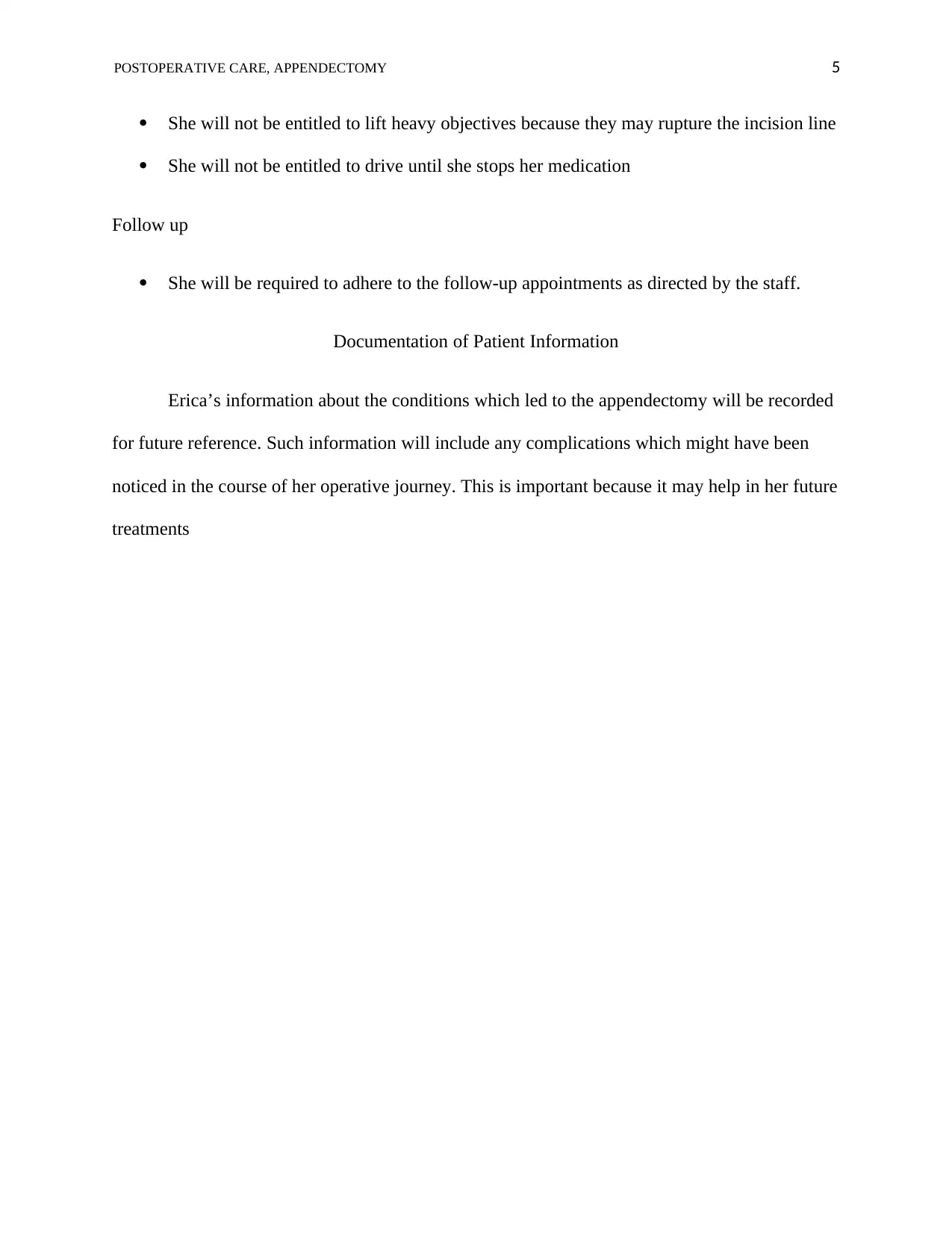
POSTOPERATIVE CARE, APPENDECTOMY 5
She will not be entitled to lift heavy objectives because they may rupture the incision line
She will not be entitled to drive until she stops her medication
Follow up
She will be required to adhere to the follow-up appointments as directed by the staff.
Documentation of Patient Information
Erica’s information about the conditions which led to the appendectomy will be recorded
for future reference. Such information will include any complications which might have been
noticed in the course of her operative journey. This is important because it may help in her future
treatments
She will not be entitled to lift heavy objectives because they may rupture the incision line
She will not be entitled to drive until she stops her medication
Follow up
She will be required to adhere to the follow-up appointments as directed by the staff.
Documentation of Patient Information
Erica’s information about the conditions which led to the appendectomy will be recorded
for future reference. Such information will include any complications which might have been
noticed in the course of her operative journey. This is important because it may help in her future
treatments
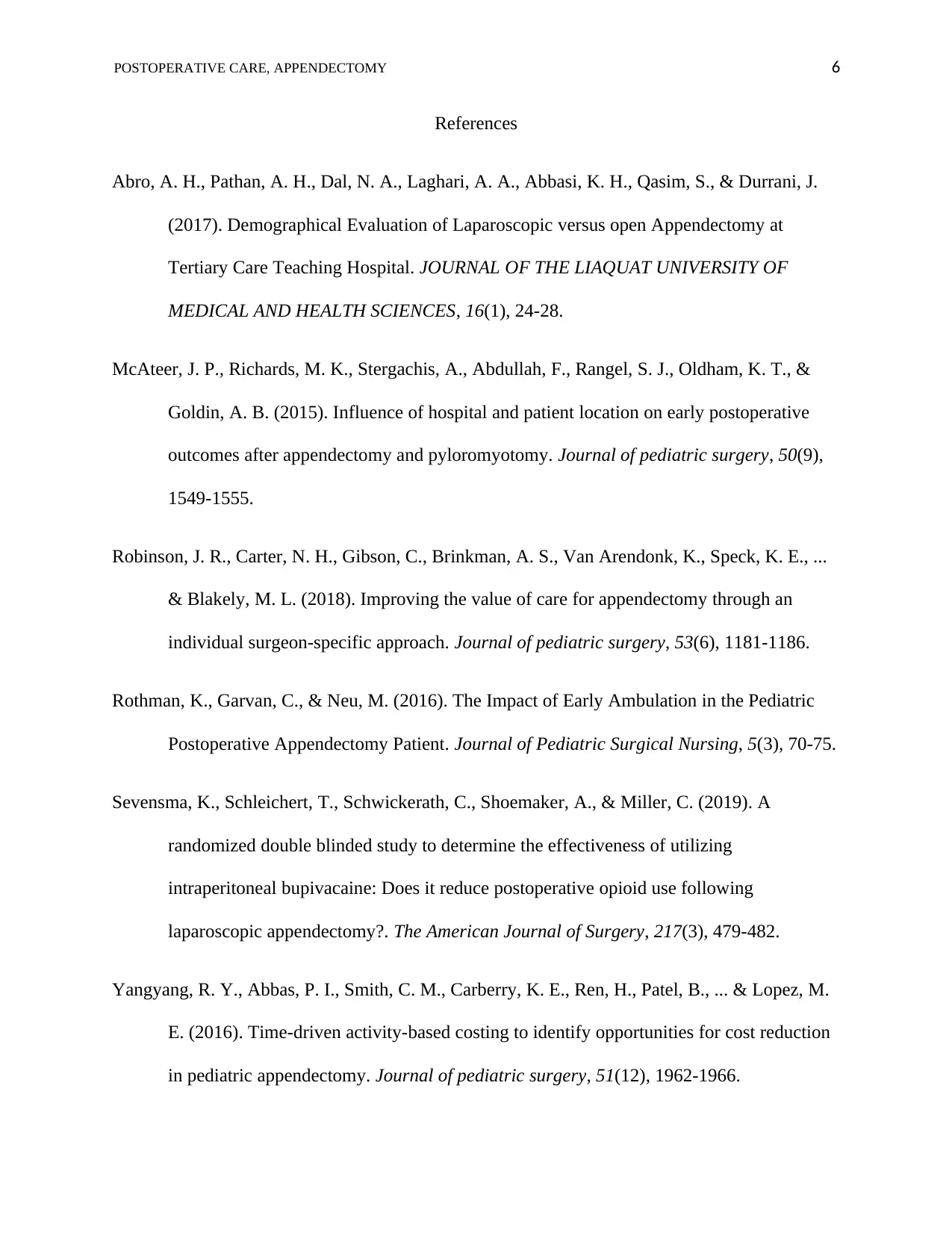
POSTOPERATIVE CARE, APPENDECTOMY 6
References
Abro, A. H., Pathan, A. H., Dal, N. A., Laghari, A. A., Abbasi, K. H., Qasim, S., & Durrani, J.
(2017). Demographical Evaluation of Laparoscopic versus open Appendectomy at
Tertiary Care Teaching Hospital. JOURNAL OF THE LIAQUAT UNIVERSITY OF
MEDICAL AND HEALTH SCIENCES, 16(1), 24-28.
McAteer, J. P., Richards, M. K., Stergachis, A., Abdullah, F., Rangel, S. J., Oldham, K. T., &
Goldin, A. B. (2015). Influence of hospital and patient location on early postoperative
outcomes after appendectomy and pyloromyotomy. Journal of pediatric surgery, 50(9),
1549-1555.
Robinson, J. R., Carter, N. H., Gibson, C., Brinkman, A. S., Van Arendonk, K., Speck, K. E., ...
& Blakely, M. L. (2018). Improving the value of care for appendectomy through an
individual surgeon-specific approach. Journal of pediatric surgery, 53(6), 1181-1186.
Rothman, K., Garvan, C., & Neu, M. (2016). The Impact of Early Ambulation in the Pediatric
Postoperative Appendectomy Patient. Journal of Pediatric Surgical Nursing, 5(3), 70-75.
Sevensma, K., Schleichert, T., Schwickerath, C., Shoemaker, A., & Miller, C. (2019). A
randomized double blinded study to determine the effectiveness of utilizing
intraperitoneal bupivacaine: Does it reduce postoperative opioid use following
laparoscopic appendectomy?. The American Journal of Surgery, 217(3), 479-482.
Yangyang, R. Y., Abbas, P. I., Smith, C. M., Carberry, K. E., Ren, H., Patel, B., ... & Lopez, M.
E. (2016). Time-driven activity-based costing to identify opportunities for cost reduction
in pediatric appendectomy. Journal of pediatric surgery, 51(12), 1962-1966.
References
Abro, A. H., Pathan, A. H., Dal, N. A., Laghari, A. A., Abbasi, K. H., Qasim, S., & Durrani, J.
(2017). Demographical Evaluation of Laparoscopic versus open Appendectomy at
Tertiary Care Teaching Hospital. JOURNAL OF THE LIAQUAT UNIVERSITY OF
MEDICAL AND HEALTH SCIENCES, 16(1), 24-28.
McAteer, J. P., Richards, M. K., Stergachis, A., Abdullah, F., Rangel, S. J., Oldham, K. T., &
Goldin, A. B. (2015). Influence of hospital and patient location on early postoperative
outcomes after appendectomy and pyloromyotomy. Journal of pediatric surgery, 50(9),
1549-1555.
Robinson, J. R., Carter, N. H., Gibson, C., Brinkman, A. S., Van Arendonk, K., Speck, K. E., ...
& Blakely, M. L. (2018). Improving the value of care for appendectomy through an
individual surgeon-specific approach. Journal of pediatric surgery, 53(6), 1181-1186.
Rothman, K., Garvan, C., & Neu, M. (2016). The Impact of Early Ambulation in the Pediatric
Postoperative Appendectomy Patient. Journal of Pediatric Surgical Nursing, 5(3), 70-75.
Sevensma, K., Schleichert, T., Schwickerath, C., Shoemaker, A., & Miller, C. (2019). A
randomized double blinded study to determine the effectiveness of utilizing
intraperitoneal bupivacaine: Does it reduce postoperative opioid use following
laparoscopic appendectomy?. The American Journal of Surgery, 217(3), 479-482.
Yangyang, R. Y., Abbas, P. I., Smith, C. M., Carberry, K. E., Ren, H., Patel, B., ... & Lopez, M.
E. (2016). Time-driven activity-based costing to identify opportunities for cost reduction
in pediatric appendectomy. Journal of pediatric surgery, 51(12), 1962-1966.
⊘ This is a preview!⊘
Do you want full access?
Subscribe today to unlock all pages.

Trusted by 1+ million students worldwide

POSTOPERATIVE CARE, APPENDECTOMY 7
1 out of 7
Related Documents
Your All-in-One AI-Powered Toolkit for Academic Success.
+13062052269
info@desklib.com
Available 24*7 on WhatsApp / Email
![[object Object]](/_next/static/media/star-bottom.7253800d.svg)
Unlock your academic potential
Copyright © 2020–2025 A2Z Services. All Rights Reserved. Developed and managed by ZUCOL.





